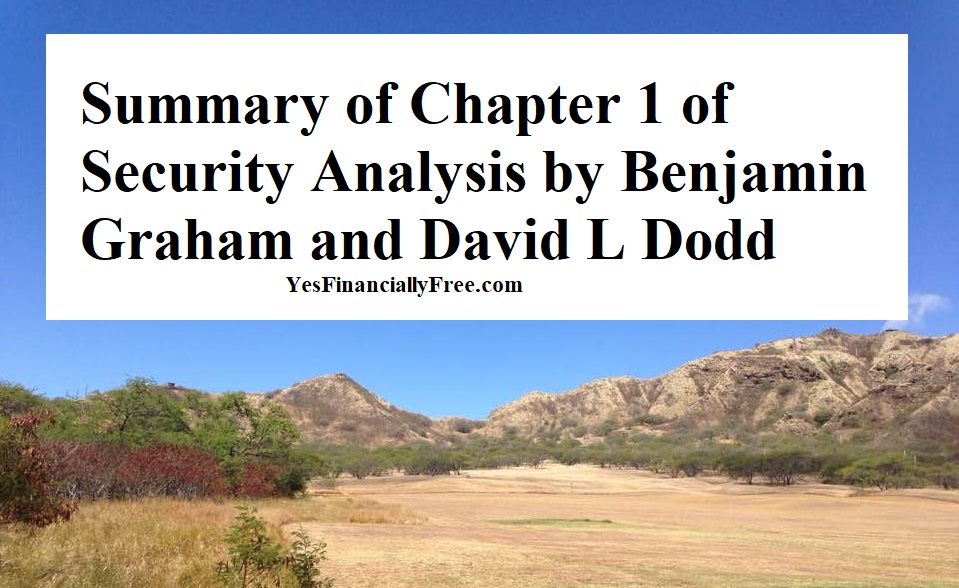
Summary of Chapter 1 of Security Analysis by Benjamin Graham and David L Dodd
Three Functions of Analysis
- Descriptive Function of Security Analysis
You can describe the bond, the stock, the company.
These are all the available statistics.
See what the company does.
Will it be able to adapt to the future.
What are other similar companies.
What is the price, earnings, etc.
- Selective Function of Security Analysis
The second function of security analysis is to use it decide whether to buy, sell, maintain or exchange a security.
He has examples in his book of how you can successfully use analysis in purchasing securities.
Here are 2 taken from p. 63:
“In 1928 the public was offered a large issue of 6% noncumulative preferred stock of St. Louis-San Francisco Railway Company priced at 100. The record showed that in no year in the company’s history had earnings been equivalent to as much as 1 1/2 times the fixed charges and preferred dividends combined. The application of well-established standards of selection to the facts in this case would have led to the rejection of the issue as insufficiently protected.
A contrasting example: In June 1932 it was possible to purchase 5% bonds of Owens-Illinois Glass Company, due 1939, at 70, yielding 11% to maturity. The company’s earnings were many times the interest requirements-not only on the average but even at that time of severe depression. The bond issue was amply covered by current assets alone, and it was followed by common and preferred stock with a very large aggregate market value, taking their lowest quotations. Here, analysis would have led to the recommendation of this issue as a strongly entrenched and attractively priced investment.”
A lot of the value in the book is in the examples.
Intrinsic Value vs. Price
The old view of intrinsic value is the book value, or how much the company is actually worth in terms of assets and liabilities, or Net Value of Assets fairly priced.
However, there is no relationship between book value and price.
Intrinsic Value vs. “Earning Power”
Another view is that the value of the company is in how much it earns and can earn in the future.
However, earnings is not correlated with the price of the security either.
The Role of Intrinsic Value in the Work of the Analyst
“It needs only to establish either that the value is adequate-e.g, to protect a bond or to justify a stock purchase – or else that the value is considerably higher or considerable lower than the market price.” (p.66)
You don’t need to be exact, you just need to have a wide margin of error.
Flexibility of the Concept of Intrinsic Value
The analyst needs to be flexible, and measure intrinsic value on a case by case basis.
One industry may need a wider margin of error than another industry.
More Definite Concept in Special Cases
In special cases, you can determine say different bonds offered by the same company, and then can be more definite in differences in values.
Principal Obstacles to Success of the Analyst
There are 3 (1) inaccurate or incorrect data (2) uncertainties of the future and (3) irrational behavior of the market.
The Hazard of Tardy Adjustment of Price Value
Sometimes, you do a great analysis, and buy a stock, but the price doesn’t adjust for a long time.
The time might be so long that the company you invested has other changes, which make your analysis change and indicate you need to sell…and you take a loss.
The Relationship of Intrinsic Value to Market Price
He has a picture that basically says all factors like price, earnings, psychology, technical factors, management, conditions, etc influence the public, who then buy and sell and create the price.
Analysis and Speculation
Do not use analysis for speculation
It will not help, as the unknown goods and bads even out over a long time, and with investment in many different stocks proven favorable from analysis…this is not what a speculator does.
- The Critical Function of Security Analysis
Analysis of accounting methods, corporate policies affecting the security owner, the quality of management (capitalization set-up, dividend and expansion policies, managerial compensation, continuing or liquidating an unprofitable business).